Deed in Lieu of Foreclosure Template
A Deed in Lieu of Foreclosure is a legal document where a homeowner voluntarily transfers their property title to the lender to avoid the lengthy and costly process of foreclosure. This option can provide a smoother resolution for both parties, allowing the homeowner to walk away from the mortgage obligation while the lender takes possession of the property. If you're considering this option, fill out the form by clicking the button below.
Open Deed in Lieu of Foreclosure Editor Here
